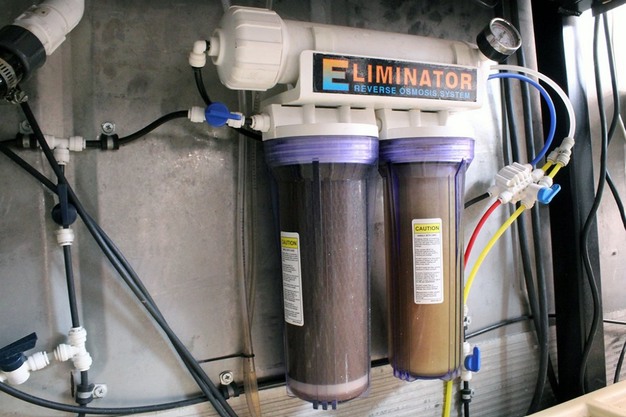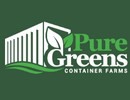Water savings is one of the biggest benefits of growing crops inside a hydroponic container farm. While we’ve written about how growing with hydroponic methods can cut water usage, we haven’t described how water flows through the system or explain the details of how hydroponics can achieve stellar water savings.
In this blog, the journey that water takes through a hydroponic system is described, from the second it enters the unit to the minute it exits.
The journey begins
“Our campaign begins with a typical garden hose. Just like how you’d use a garden hose to water a soil-based garden, a hose is the first step to providing your container farm with water. There’s a spot at the back of the container that attaches to the hose, with a valve to change the flow’s intensity,” says the Pure Greens team.
You don’t have to filter the water or do anything special, almost any water will do. The magic begins once the flow enters the container farm. Inside, the water mixes with a nutrient concentration and becomes purified through the reverse osmosis process. There, we find the real value of this liquid.
Inside, where to next?
After water enters the container, it flows inside pipes that lay along the bottom edge of the container’s interior. Once the water starts flowing, the pressure behind the flow will ensure that it travels smoothly through each stage of the system.
The next stop on the water’s journey is the nutrient solution reservoir, but before we discuss that, let’s provide some foundation for what needs to happen to the water before it’s mixed with nutrients.

Reverse osmosis
“Inside the nutrient reservoir, we have a system that performs reverse osmosis (RO). The process of reverse osmosis demineralizes the water, pressuring water through a semi-permeable membrane.”
This is to ensure the removal of dissolved salts, particles, colloids, organics, and bacteria from the feed water before you can add it to a nutrient mix. After purifying the water, it can mix with nutrients inside the reservoir.
The nutrient reservoir: a hydroponic heart
This is where all the action happens. Water enters the reservoir near a float valve, a hollow, sealed float that ensures that the nutrient reservoir has enough liquid, but not too much that it overflows.
Once inside the reservoir, the water mixes with nutrients, typically a chemical mixture known as NPK: Nitrogen, Phosphorus, and Potassium. While these are the primary groups of nutrients that plants require, you may also see Calcium and Magnesium (CalMag) used to feed plants. The rapid absorption of essential nutrients enables the rapid plant growth that hydroponics boasts of.
After mixing the solution, the loop can begin. Here’s where hydroponics’ water savings come into play. The solution is first pushed through a water chiller, that reduces the temperature of the nutrient solution to a level that’s comfortable for the plants to absorb. At commercial scales, a water chiller is essential to ensuring optimal growth, and it plays a key role in CEA.
Direct delivery
After chilling, the solution moves to two separate pipes that bring the flow to either side of the container farm. Then, a series of pipes distribute the solution to every growing tray in the system, providing each level of plant with an even level of solution.
The plants’ roots dip down into this flow, allowing each to absorb the nutrient-rich solution precisely, ensuring a consistent and optimal supply for their growth. The orchestrated distribution system plays a crucial role in maximizing efficiency and promoting a uniform distribution of solutions across the entire container farm.
Exiting the container – the end?
Wastewater from the reverse osmosis process leaves the system in addition to overflow water that comes from the nutrient solution reservoir. This water may contain a higher percentage of dissolved solids (minerals, salts, and organic matter) as a byproduct of the RO process, and can’t be reused as a system input.
However, that doesn’t mean that you can’t use this water for anything. You can use it to water outdoor plants or use it to clean messy floors, dirty windows, or dusty cars.
“Our Head Grower said certain plants (namely heavy fruiting plants like tomatoes, peppers and eggplants) are more sensitive to the higher levels of minerals left in the wastewater, but certain plants can thrive in those circumstances, like carrots and onions.”
 For more information:
For more information:
Pure Greens
+1 833 217 4025
https://puregreensaz.com